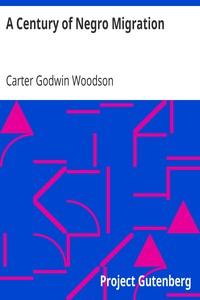|
|
Read this ebook for free! No credit card needed, absolutely nothing to pay.Words: 50376 in 24 pages
This is an ebook sharing website. You can read the uploaded ebooks for free here. No credit cards needed, nothing to pay. If you want to own a digital copy of the ebook, or want to read offline with your favorite ebook-reader, then you can choose to buy and download the ebook.

: A Century of Negro Migration by Woodson Carter Godwin - Migration Internal United States; African Americans Northeastern States; African Americans Migrations History; Rural-urban migration United States History@FreeBooksTue 06 Jun, 2023 BIBLIOGRAPHY INDEX MAPS AND DIAGRAMS Map Showing the Per Cent of Negroes in Total Population, by States: 1910 Diagram Showing the Negro Population of Northern and Western Cities in 1900 and 1910 Maps Showing Counties in Southern States in which Negroes Formed 50 Per Cent of the Total Population FINDING A PLACE OF REFUGE The migration of the blacks from the Southern States to those offering them better opportunities is nothing new. The objective here, therefore, will be not merely to present the causes and results of the recent movement of the Negroes to the North but to connect this event with the periodical movements of the blacks to that section, from about the year 1815 to the present day. That this movement should date from that period indicates that the policy of the commonwealths towards the Negro must have then begun decidedly to differ so as to make one section of the country more congenial to the despised blacks than the other. As a matter of fact, to justify this conclusion, we need but give passing mention here to developments too well known to be discussed in detail. Slavery in the original thirteen States was the normal condition of the Negroes. When, however, James Otis, Patrick Henry and Thomas Jefferson began to discuss the natural rights of the colonists, then said to be oppressed by Great Britain, some of the patriots of the Revolution carried their reasoning to its logical conclusion, contending that the Negro slaves should be freed on the same grounds, as their rights were also founded in the laws of nature. And so it was soon done in most Northern commonwealths. Vermont, New Hampshire, and Massachusetts exterminated the institution by constitutional provision and Rhode Island, Connecticut, New Jersey, New York and Pennsylvania by gradual emancipation acts. And it was thought that the institution would soon thereafter pass away even in all southern commonwealths except South Carolina and Georgia, where it had seemingly become profitable. There came later the industrial revolution following the invention of Watt's steam engine and mechanical appliances like Whitney's cotton gin, all which changed the economic aspect of the modern world, making slavery an institution offering means of exploitation to those engaged in the production of cotton. This revolution rendered necessary a large supply of cheap labor for cotton culture, out of which the plantation system grew. The Negro slaves, therefore, lost all hope of ever winning their freedom in South Carolina and Georgia; and in Maryland, Virginia, and North Carolina, where the sentiment in favor of abolition had been favorable, there was a decided reaction which soon blighted their hopes. In the Northern commonwealths, however, the sentiment in behalf of universal freedom, though at times dormant, was ever apparent despite the attachment to the South of the trading classes of northern cities, which profited by the slave trade and their commerce with the slaveholding States. The Northern States maintaining this liberal attitude developed, therefore, into an asylum for the Negroes who were oppressed in the South. The Negroes, however, were not generally welcomed in the North. Many of the northerners who sympathized with the oppressed blacks in the South never dreamt of having them as their neighbors. There were, consequently, always two classes of anti-slavery people, those who advocated the abolition of slavery to elevate the blacks to the dignity of citizenship, and those who merely hoped to exterminate the institution because it was an economic evil. The latter generally believed that the blacks constituted an inferior class that could not discharge the duties of citizenship, and when the proposal to incorporate the blacks into the body politic was clearly presented to these agitators their anti-slavery ardor was decidedly dampened. Unwilling, however, to take the position that a race should be doomed because of personal objections, many of the early anti-slavery group looked toward colonization for a solution of this problem. Some thought of Africa, but since the deportation of a large number of persons who had been brought under the influence of modern civilization seemed cruel, the most popular colonization scheme at first seemed to be that of settling the Negroes on the public lands in the West. As this region had been lately ceded, however, and no one could determine what use could be made of it by white men, no such policy was generally accepted. When this territory was ceded to the United States an effort to provide for the government of it finally culminated in the proposed Ordinance of 1784 carrying the provision that slavery should not exist in the Northwest Territory after the year 1800. This measure finally failed to pass and fortunately too, thought some, because, had slavery been given sixteen years of growth on that soil, it might not have been abolished there until the Civil War or it might have caused such a preponderance of slave commonwealths as to make the rebellion successful. The Ordinance of 1784 was antecedent to the more important Ordinance of 1787, which carried the famous sixth article that neither slavery nor involuntary servitude except as a punishment for crime should exist in that territory. At first, it was generally deemed feasible to establish Negro colonies on that domain. Yet despite the assurance of the Ordinance of 1787 conditions were such that one could not determine exactly whether the Northwest Territory would be slave or free. The Ordinance of 1787 did not disturb the relation of slave and master. Some pioneers thought that the sixth article exterminated slavery there; others contended that it did not. The latter believed that such expressions in the Ordinance of 1787 as the "free inhabitants" and the "free male inhabitants of full size" implied the continuance of slavery and others found ground for its perpetuation in that clause of the Ordinance which allowed the people of the territory to adopt the constitution and laws of any one of the thirteen States. Students of law saw protection for slavery in Jay's treaty which guaranteed to the settlers their property of all kinds. When, therefore, the slave question came up in the Northwest Territory about the close of the eighteenth century, there were three classes of slaves: first, those who were in servitude to French owners previous to the cession of the Territory to England and were still claimed as property in the possession of which the owners were protected under the treaty of 1763; second, those who were held by British owners at the time of Jay's treaty and claimed afterward as property under its protection; and third, those who, since the Territory had been controlled by the United States, had been brought from the commonwealths in which slavery was allowed. Freedom, however, was recognized as the ultimate status of the Negro in that territory. Free books android app tbrJar TBR JAR Read Free books online gutenberg More posts by @FreeBooks
: The Ghost Pirates by Hodgson William Hope - Science fiction; Sea stories; Fantasy fiction; Horror tales; Pirates Fiction Pirates Buccaneers Corsairs etc.; Science Fiction@FreeBooksTue 06 Jun, 2023

: The World Turned Upside Down Or No News and Strange News by Anonymous - Children's poetry; Picture books for children Children's Picture Books@FreeBooksTue 06 Jun, 2023
|
Terms of Use Stock Market News! © gutenberg.org.in2025 All Rights reserved.






